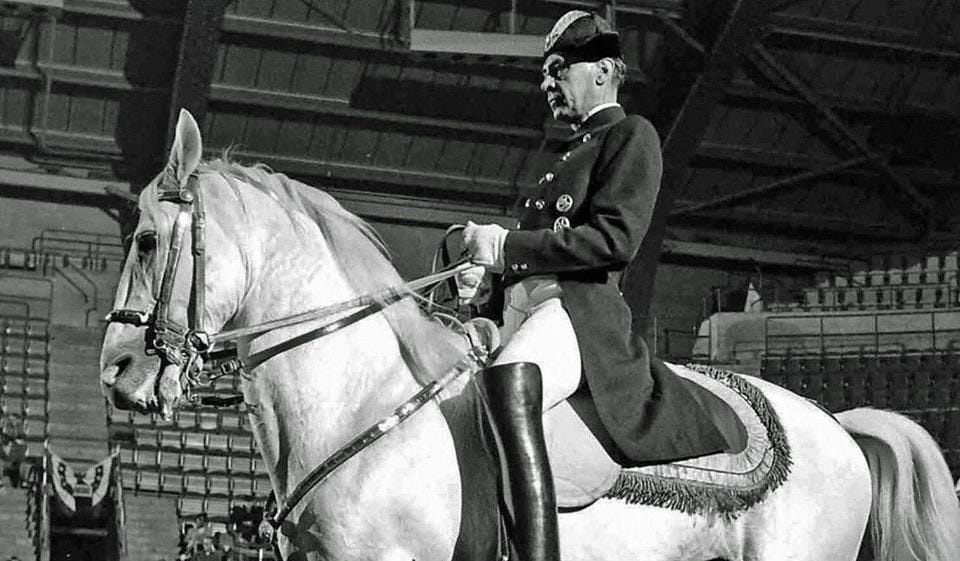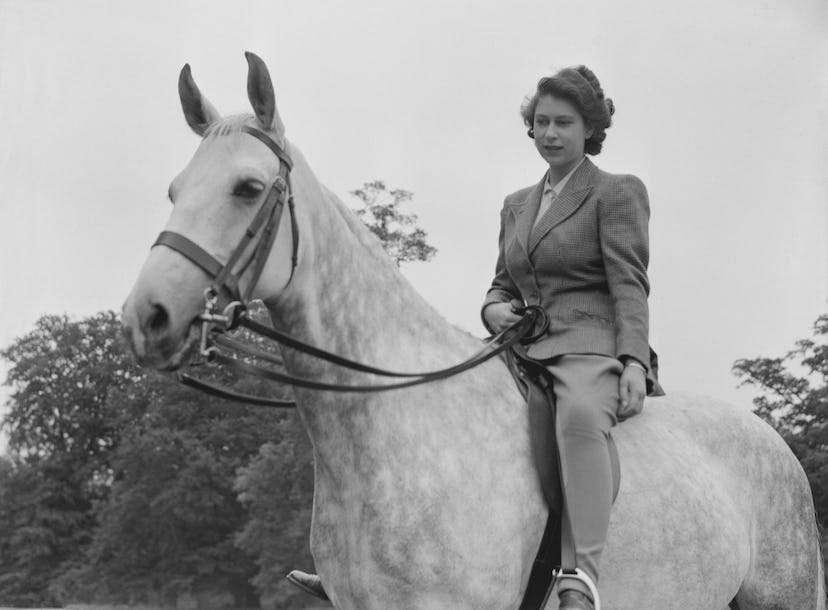The Queen's Steed
When one legend carried another
Housekeeping: To my paying subscribers, thank you all for your patience, and please accept my apologies for the unannounced end-of-summer/beginning-of-teaching-year pause in new content especially for you. A subscriber-exclusive post on horror and the demonic is hopefully coming tomorrow, and you can expect a little burst of more material in the coming days as I wrap up a few loose ends from my summer vacationing, reading, etc.—some of which will hopefully be of interest to at least some of you. Again, thank you for your contributions.
The Queen is dead. I was teaching logic and rhetoric through the first hour after the news broke, so that by the time I checked the news, takes were in full flow. The New York Times was obviously ready to hit publish on this bit of presentist blather, which decides now is the moment to Have the Conversation about how even though the queen oversaw mass decolonisation, she was still an imperialist racist and a genocide fan, probably. Also a good moment to remind everyone that she was still “another white face” circulating on the British currency in a “rapidly diversifying” country. It’s certainly one of the worst takes out there, but competition is fierce, and this cycle is still young. We have a long few weeks to look forward to. You’d be better served just re-reading J. S. Milbank’s exquisite eulogy over at The Critic. My friend Ben Sixsmith also adds his customary economically tasteful .02 here.
Appropriately, people are using the occasion to recall the best moments, speeches, and stories from Her Majesty’s long and graceful career. My own mind kept going back to one image in particular: the image of the young queen on a horse. Not just any horse—a white Lipizzan stallion, trained in the famous Spanish Riding School of Vienna. I haven’t yet pinned down for myself whether this is a memory of an actual photo I saw, or just the picture in my own imagination when I read the story that gave rise to it. But I did rediscover the story, which is more important.
An avid horse-lover since age three, Elizabeth kept her riding skills sharp well into her old age. But she had a special fondness for the Lipizzaners, who barely escaped slaughter during World War II. An American film, Miracle of the White Stallions, depicts the drama of the horses’ evacuation—the stallions outrunning the Nazis, their mares in Czechoslovakia outrunning the Red Army. It made excellent feel-good Hollywood fodder, as we Americans come out of the story looking helpful and humane, if a little clumsy. The movie starred Robert Taylor in a brazenly accent-less turn as the school’s director, Colonel Alois Podhajsky. Podhajsky wrote the book on which the script was based, as well as other works about the deep bond between him and his “dancing white horses.”
My mother, also a keen student of the Riding School’s history, collected several of these books, some of which are hard to find now. Fortunately, the one titled My Horses, My Teachers isn’t one of them. When I ordered it on Kindle yesterday, I crossed my fingers hoping this would be the one that had the Queen Elizabeth story in it, the one I remembered Mom telling me without remembering exactly which book it came from. To my delight, it was.
In 1953, the young queen was a year into her reign. Podhajsky and the School were invited to give a performance for the Royal Family, after which they were invited to Kensington Palace. There Podhajsky learned that Elizabeth had read one of his books with intense interest and could converse fluently with him about the horses’ dressage techniques. She was especially “full of admiration” for Podhajsky’s mount, the great Pluto Theodorosta, who was famous for his caprioles (leaps). “Although led only with one hand on the curb,” she observed, “he performed the most difficult exercises with great harmony and regularity. I have been most impressed that he did not do a single unlevel step at the passage, although he splashed through the water [from a recent storm]. Most horses would try to avoid the puddles.” After bombarding Podhajsky with more questions about Pluto’s training, she asked tentatively if the colonel thought she would be capable of riding him herself. Podhajsky gave her a warm affirmative answer. She hesitated, suddenly reticent. Later, after she was escorted out of the party, the Duke of Beaufort returned to give Podhajsky a message in the form of a question: Did you really mean I could ride your horse, or did you say yes out of mere politeness?
Of course, she asked this in all innocence, not knowing Colonel Alois Podhajsky well enough to know he was a man who said what he meant, and meant what he said.
A lively Court debate ensued, with some in the “nay” column pressing their concern that “it would be irresponsible to expose Her Majesty to the risk of being harmed by a foreign horse trained by a foreign rider from a foreign country, … etc., etc.…” Fortunately, the ayes had it.
On July 25, the great horse was carefully transported to meet the queen at the palace, where she mounted him in the indoor arena. Taking up the reins, she asked the colonel who else rode the stallion besides himself. No one, he answered. When he was gone, they always walked Pluto by hand. Elizabeth took a deep breath: “And I of all people should be the first strange rider on his back!”
Podhajsky walked alongside them, quietly holding his own breath. But his fears gradually subsided as Pluto moved from walk to trot to canter. Elizabeth was in awe, marveling out loud at how smooth this horse was in all his movements. Praise that must have greatly warmed Podhajsky’s heart, since he knew Pluto’s movements hadn’t always been so smooth. The horse’s training was greatly delayed by early assignment to a weak rider, leaving him at risk of being a permanent reject. His corrective process was painfully slow, but under Podhajsky’s hand, Pluto unstiffened and blossomed into the powerful, graceful creature who now carried the Queen of England.
The basic paces had been so uneventful that Podhajsky asked if Elizabeth would like to try a couple of the Lipizzans’ signature moves: a piaffe and a passage. “Oh, I should love to,” the Queen said, “But I don’t know what to do!”
With minimal instruction and a touch of the whip, Pluto executed the steps flawlessly. Podhajsky could only watch in awe. So this was what he looked like. This was what it was to be a spectator. A witness to that mystic union of Man and Horse, here actualized in the union of a slender queen and a great stallion, who moved as if he knew that this was his finest hour.
Her cheeks flushed with pride as they slowed and finally stopped. She looked as if she was ready to burst, as if she was eleven years old all over again. She was thrilled, she said. She was utterly thrilled. And he was utterly glad.
Her Majesty is on a majestic horse. My majestic horse. My beautiful majestic white horse.
Podhajsky would later write that this moment represented the coronation—as it were—of all his work and training instruction. The essence of dressage is “to train a horse in such a way that he gives a comfortable ride at any moment and to anybody without any special instructions or the revelation of any secrets.” That day, his reward was royal indeed.
The stallion’s fame quickly spread, until his name had become one more bit of the aura around the young monarch. Months later, Podhajsky would get a fan letter addressed to “Mr. Pluto Theodorosta, Austria.” Podhajsky’s name had slipped the writer’s mind, evidently.
Pluto would have many more happy, golden years at the School, until Podhajsky retired him at age twenty-nine. Or, rather, attempted to retire him. Pluto was not about to go gently into his good night. The door of his box was always left open, which his handlers would regret on the day he trotted out through the courtyard and across the street to the riding school. His poor groom stood frozen in fear as a bus approached. But Pluto paused to take stock of the traffic, waited patiently, and found his moment to cross over in dignified fashion. Podhajsky didn’t have the heart to refuse the old creature’s unspoken request. They would ride through that great hall together for one year more, until the day Podhajsky dismounted and took off Pluto Theodorosta’s saddle for the last time. The horse would live to be thirty-two. At last, on a hot summer day, his great heart ceased to beat.
In her old age, the queen would be showered with horse-themed gifts from all manner of foreign dignitaries. In 1999, Hungary presented her with a porcelain model of her 11-year-old self on horseback. In 2015, Mexico presented her with another work of art, depicting her on horseback together with the king consort. In Mongolia, she accepted a traditional fiddle decorated on top with a horse’s head. In the Netherlands and Canada, she received actual horses.
But I have to imagine no gift pleased her so much as the gift she received in 2008, in Slovenia, when she was presented with her very own white stallion of Lipizza. Young Kanizo, sixteen at the time, was one of only 9,000 of his kind still living. He was the finest they had to give. But he was restless as she passed by. He shied and reared for the camera. You can see the whites of his eyes in some pictures.
What was she thinking, I wonder, as she watched that marvelous, nervous creature dance? Was she perhaps remembering another day, so long ago, when she asked the colonel so timidly, “May I? May I really?”
I would like to imagine her on a white horse now, her seat impeccable, her head high, her cheeks flushed. In this timeless moment, I would like to imagine that she appears somehow neither young nor old. I would like to imagine her looking ageless, as the dead in Christ all shall look, when we shall see them reanimated.



